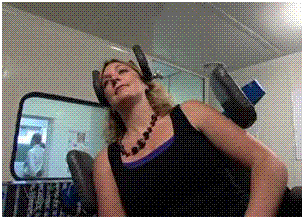
Welcome to the Center for Disability Resources Library Blog! Here we will welcome your comments and suggestions about books and videos that you have borrowed, materials that you would like to see purchased, or anything involving the day-to-day operations of the library or even of disabilities in general. Visit the CDR Library's web site!
Friday, October 30, 2009
Master Regulator Found For Regenerating Nerve Fibers

Thursday, October 29, 2009
Is It A Visual Problem Or Alzheimer's? New Data Helps Doctors Make The Diagnosis
 ScienceDaily (Oct. 27, 2009) — Sometimes when a patient tells his ophthalmologist that he "can't see," what he really means is "I can see, but I can no longer read or write." In a minority of Alzheimer's patients the disease shows up first as problems with vision rather than memory or other cognitive functions. But diagnosis can be difficult because standard eye exams are often inconclusive for these patients.
ScienceDaily (Oct. 27, 2009) — Sometimes when a patient tells his ophthalmologist that he "can't see," what he really means is "I can see, but I can no longer read or write." In a minority of Alzheimer's patients the disease shows up first as problems with vision rather than memory or other cognitive functions. But diagnosis can be difficult because standard eye exams are often inconclusive for these patients.Neuro-ophthalmologists Pierre-Francois Kaeser, MD, and Francois-Xavier Borruat, MD, Jules Gonin Eye Hospital, Switzerland, examined and followed 10 patients with unexplained vision loss who were ultimately diagnosed with the visual variant of Alzheimer's disease (VVAD). Their study -- presented at the 2009 Joint Meeting of the American Academy of Ophthalmology and the Pan-American Association of Ophthalmology (PAAO) -- describes clinical clues that may improve ophthalmologists' ability to detect VVAD and refer patients for further tests. When patients receive neurological assessment, treatment and family counseling early in the disease, outcomes may be better for all concerned.
To view the entire article, please click on the link above.
Wednesday, October 28, 2009
Cochlear Implants Reduce Delay Suffered By Deaf Children In Language Acquisition, Study Shows

Tuesday, October 27, 2009
Fine-tuning Treatments For Depression

Monday, October 26, 2009
Mercury Levels In Children With Autism And Those Developing Typically Are The Same, Study Finds

Friday, October 23, 2009
Popular Antidepressant Associated With A Dramatic Increase In Suicidal Thoughts Amongst Men, Study Finds

Thursday, October 22, 2009
STAR equipment pickups coming up in South Carolina

Please call Walton Options or one of our STAR partners if you want to be a part of these routes. More information can be found at:
http://www.sc.edu/scatp/reutilization.html
Redefining Dementia as a Terminal Illness

Wednesday, October 21, 2009
'ECG For The Mind' Could Diagnose Depression In An Hour

Monash biomedical engineer Brian Lithgow has developed electrovestibulography which is something akin to an 'ECG for the mind'. Patterns of electrical activity in the brain's vestibular (or balance) system are measured against distinct response patterns found in depression, schizophrenia and other Central Nervous System (CNS) disorders.
The vestibular system is closely connected to the primitive regions of the brain that relate to emotions and behaviour, so Lithgow saw the diagnostic potential of measuring and comparing different patterns of electrovestibular activity.
Working with psychiatry researchers at Monash University's Alfred Psychiatry Research Centre (MAPrc) in Melbourne, Australia, he tested volunteers and found distinct response patterns, or "biomarkers", that distinguished different CNS diseases from each other and from regular electrovestibular activity.
To view the entire article, please click on the link above.
Tuesday, October 20, 2009
Scientists Remove Amyloid Plaques From Brains Of Live Animals With Alzheimer's Disease

Monday, October 19, 2009
Stroke Rehabilitation Technology That's Fun And Can Be Used At Home

Therapists, doctors, engineers and psychologists at the University have come together to set up ARM (Assessment, Rehabilitation, Movement) – a unique initiative that is using ideas from industrial robots to help patients regain and control movement of the arm and hand after a stroke.
"We felt it was important for people to have fun while they recovered," said Professor Jane Burridge of the University of Southampton’s School of Health Sciences. "In fact we find it’s often difficult to get them to stop playing the computer games!"
Friday, October 16, 2009
What ideas and actions can increase access to affordable and reliable transportation services for people with disabilities, older adults, and people w

Thursday, October 15, 2009
New Studies See a Higher Rate of Autism: Is the Jump Real?

Wednesday, October 14, 2009
SC AT Exchange - Big Ticket Items for Sale
 Big Ticket Items Available NOW on the South Carolina Assistive Technology Exchange. Drastically lower than Retail!
Big Ticket Items Available NOW on the South Carolina Assistive Technology Exchange. Drastically lower than Retail!Go to www.scatpexchange.net and check them out! You can easily become a member, sign in, and view the items needed and those that are free or for sale.
House - Wheelchair accessible $160000
Winsford Feeder $800 or Best Offer
Ceiling Track Lift $900
High Low Chair $400 or Best Offer
Jazzy Power Chair 1120 $850 or Best Offer
Jazzy Pride 1121 Power Wheelchair Best Offer
Merits P182 Power Wheelchair $3000 or Best Offer
Mini Jazzy 1103 Power Wheelchair Free
Hoyer Deluxe Lifter HPL402 $700 or Best Offer
Merius Power Wheelchair $900 or Best Offer
Jazzy 1120/2000 Power Wheelchair $1000 or Best Offer
Permobil C300 $11000 or Best Offer
Pride Jet 2 Heavy Duty Scooter $400 or Best Offer
Pride LX 12 Power Wheelchair $4000 or Best Offer
Therapy Air Mattress APM2 $770 or Best Offer
Youth caregiver operated Quickie Wheelchair Best Offer
Invacare 2005 hydraulic patient lift device $600 or Best Offer
Guldman GH2 Power patient lift device $1500 or Best Offer
Freedom Designs Libre small youth wheelchair Best Offer
Rifton Adaptive Tricycle $750 or Best Offer
Assistive Tech Mercury II Communicator $4500 or Best Offer
ERICA Eye Gaze Speech Generating Device $6800
Dodge 2500 Wheelchair Access $8500
Harmar AL500 wheelchair lift $1700 or Best Offer
1990 GMC Vandura with Crow River lift $6000 or Best Offer
2005 Toyota Sienna LE Rampvan $35000 or Best Offer
2006 Dodge Grand Caravan SXT w/Braun $29500
Wheelchair lift, vannator /2000 $800 or Best Offer
To view the SC AT Exchange website, please click on the link above.
Mechanism That Constructs Key Brain Structure Discovered

Scientists have known for years that information processing in the cerebral cortex depends upon groupings of neurons that assemble in the shape of vertical columns. If the number and mix of neurons in the column are wrong, severe cognitive problems can result. For instance, malformations of these columns have been implicated in some forms of autism and mental retardation. Scientists, however, have not been able to find the molecular mechanism responsible for this intermixing.
In the Nature paper, a team led by Pasko Rakic, professor and chairman of the Department of Neurobiology and head of the Kavli Institute for Neuroscience, describes one of the molecular mechanisms essential to the organizations of these key structures.
To view the entire article, please click on the link above.
Tuesday, October 13, 2009
Enzyme May Be A Key To Alzheimer's-related Cell Death

Monday, October 12, 2009
Men Nearly Three Times As Likely To Develop Noise-induced Hearing Loss
 ScienceDaily (Oct. 6, 2009) — A comprehensive study of the prevalence and risk factors for noise-induced hearing loss (NIHL) show that men, especially those who are white and married, are significantly more at risk than women, according to new research presented at the 2009 American Academy of Otolaryngology-Head and Neck Surgery Foundation (AAO-HNSF) Annual Meeting & OTO EXPO, in San Diego, CA.
ScienceDaily (Oct. 6, 2009) — A comprehensive study of the prevalence and risk factors for noise-induced hearing loss (NIHL) show that men, especially those who are white and married, are significantly more at risk than women, according to new research presented at the 2009 American Academy of Otolaryngology-Head and Neck Surgery Foundation (AAO-HNSF) Annual Meeting & OTO EXPO, in San Diego, CA.The study, which analyzed the audiometric testing data from 5,290 people between the ages of 20 and 69 years indicates that more than 13 percent of subjects suffer from NIHL, which would correspond with approximately 24 million Americans suffering from the ailment. The strongest association was of gender, where men are 2.5 times more likely to develop NIHL than women. Among that group, married white (non-Hispanic) men represent the highest risk group for developing NIHL.
NIHL is a preventable and increasingly prevalent disorder that results from exposure to high-intensity sound, especially over a long period of time.
Friday, October 09, 2009
Telephone Depression Program Offers Benefits At A Moderate Cost

Thursday, October 08, 2009
AAIDD F.Y.I. October 2009

Dear AAIDD Friends and Colleagues:
*The new definition and classification manual of Intellectual
Disability by the American Association on Intellectual and
Developmental Disabilities is here.
Intellectual Disability: Definition, Classification, and Systems of
Supports, the new 11th edition of the definition and classification system by the American Association on Intellectual and Developmental
Disabilities (AAIDD) is now published. This is the first official AAIDD
definition manual with the terminology Intellectual Disability
(formerly mental retardation). To learn more about this progressive
system of diagnosing and classifying the condition of intellectual
disability, visit http://www.aaidd.org/intellectualdisabilitybook/. To
purchase the Manual, visit http://bookstore.aaidd.org/.
Written by a committee of 18 experts over seven years, the AAIDD definition system is based on the global notion that intellectualdisability is not a static life-long trait, but a condition that can beenhanced with the provision of proper supports. The 11th edition of themanual was based on a synthesis of current information and best practices regarding intellectual disability; numerous reviews and critiques of the 10th edition of the AAIDD definition manual; and feedback from the field regarding a series of articles published by the Committee.
*Nearly two-thirds of the 36 children who have died due to the H1N1 flu between April and August experienced a form of developmental
disability, CDC report says.
CDC reported that of the 36 children died due to the H1N1 flu betweenApril 2009 to the first week in August, 22 had neurodevelopmentalconditions such as developmental delay or cerebral palsy. Thirteen ofthose children had more than one neurodevelopmental diagnosis, and ninehad both neurodevelopmental and chronic pulmonary conditions. Read more:http://www.cdc.gov/mmwr/preview/mmwrhtml/mm5834a1.htmThe mortality figure has since risen. By mid-September, CDC reported atotal of 49 children had died from H1N1 flu, four of those since August30. CDC posts weekly flu surveillance reports onhttp://www.cdc.gov/flu/weekly/index.htm#MS
*The National Institute of Child Health and Human Development
presents for public comment a report highlighting among other
issues, areas of future expansion in the field of intellectual and
developmental disability research.
In this report by an expert panel on the current work and futuredirections of the NICHD's IDD Branch, the group supported a paradigmshift in IDD research to integrate the IDD field more broadly, ratherthan focus on individual, rare disorders. The panel felt this shiftcould encourage investigators to rethink the IDD field from theperspective of shared paths of investigation, systems approaches, andinterrelated networks, "with the goal of developing interventions thatmay generalize across many conditions. This would promote development of interventions for a wider population of individuals with IDD.The comment period ends October 16.The panel supported work in several directions:Research on therapeutic interventions for IDDEarly identification and diagnosis via newborn screeningResearch on adolescent brain developmentHealth disparities and health promotion research related to IDDTraining initiatives in the IDD fieldThe draft is available at
http://www.nichd.nih.gov/news/releases/upload/DRAFT_IDD_Branch_Council_Report_Sept_2009.pdf
*Join a series of free aging and end-of-life webinars from experts around the country through February 2010.
AAIDD Executive Director Doreen Croser moderates this month's webinar,Competence and Compassion: Critical Qualities in Effective Supports forIndividuals with Dementia, on Wednesday, October 21 from 1 p.m. to 2 p.m. Eastern time. This is the second in a free webinar series on aging and end-of-life. Speaker Genny Pugh, MA, LPA, FAAIDD, Executive Director, Turning Point Services, will explore practical approaches to creating environments, individual supports, and relationships aimed at preserving functional skills and promoting wellness and quality of life for those with dementia.The series is hosted by AAIDD and the RRTC on Aging and DevelopmentalDisabilities at the University of Illinois at Chicago.Each webinar is free, but https://www1.gotomeeting.com/register/481066657 For more about future topics and speakers, go tohttp://www.aaidd.org/CONTENT_276.CFM
*A National Standards Report provides comprehensive overview of the scientific evidence in support of the many education and behavioral
treatments currently available for people with Autism Spectrum
Disorders.
The National Autism Center has released its National Standards Report,which it describes as the most comprehensive analysis of treatments ofchildren and adolescents with autism spectrum disorders ever published.The report identifies 11 established treatments that are known to beeffective for individuals on the autism spectrum, as well as 22emerging treatments that have shown some evidence of effectiveness, butnot enough to be confident they are truly effective. Finally, the reportdescribes five unestablished treatments for which there is no soundevidence of effectiveness [and] no way to rule out the possibility thesetreatments are ineffective or harmful.The goal of the survey is to give families and professionals better tools for making treatment decisions to meet the needs of individuals with autism spectrum disorders. Read more in National Autism Center's news release at HTTP://NEWS.PRNEWSWIRE.COM/DISPLAYRELEASECONTENT.ASPX?ACCT=104&STORY=/WWW/STORY/09-22-2009/0005098108&EDATE For information on downloading the report, go tohttp://www.nationalautismcenter.org/affiliates/reports.php
Brain-Computer Interface Allows Person-to-person Communication Through Power Of Thought

Wednesday, October 07, 2009
Difficulties With Daily Activities Associated With Progression To Dementia

Tuesday, October 06, 2009
Non-coding RNA Called Evf2 Is Important For Gene Regulation

Monday, October 05, 2009
Upcoming Trainings at SCATP

- Accessible and Usable Web Pages Using CSS – October 6
- Trash to AT Treasures - October 21
- "What's New in Text-to-Speech?" - October 27
- Building or Updating Your Home for Accessibility - October 28
- "AMPLIFY ! LIFE" - Grab Life by the Phone. How to get specialized phone equipment FREE - November
- AAC Assessment - November 12, 2009
- Accessible and Usable Web Pages Using CSS – December 1
- AAC Implementation - December 10
Walton Options HubScrub Event - Anderson - Oct 16

Walton Options for Independent Living, Inc. announces a new cleaning service to benefit the general public, people with disabilities, seniors, and other users of durable medical equipment (DME). In addition, this new service can also assist the local schools and daycare providers by disinfecting and sanitizing desks, chairs, toys, etc, helping to decrease … the spread of germs during this flu season. As a partner with the Southeastern Technology Access and Reuse Network (STAR), Walton Options accepts donated used equipment. The equipment is then cleaned, sanitized, and redistributed throughout South Carolina. This innovative program saves dollars, benefits the uninsured/underinsured, and promotes a greener alternative to landfill disposal by recycling the components.
To bring awareness to your community about the Cleaning Services of Walton Options and the STAR program, Walton Options will be providing cleaning services to the general public at the Disability Fair: Access Anderson - hosted by the Anderson Mayor's Committee on Disabilities on Friday, October 16, 2009 at the Anderson County Farmer's Market from 9 am-3pm.
Users and providers of durable medical equipment will have an opportunity to have their equipment inspected, cleaned and sanitized for a donation. This will allow the community a great opportunity to see the benefits of utilizing the service. We use a Hub Scrub machine designed to sanitize large items and large quantity of items. Some items that are typically sanitized are manual wheelchairs, walkers, shower chairs, toys, desks, and student chairs just to name few (no electronic devices). This is a win-win situation for everyone. It helps foster safe, clean equipment to benefit the overall well-being of all involved.
Bring your items to be cleaned.
Donate any unused durable medical equipment to help others in your community and state. We look forward to seeing you at the fair.
For more information, contact at Walton Options, 706-724-6262.
New school in east Orange built on 'inclusion' of kids with disabilities

Friday, October 02, 2009
Employment group broadens how disabilities are defined

Thursday, October 01, 2009
Anderson Disability Fair - Free To All - October 16, 2009

- Find out what services, programs, equipment, funding, education and employment opportunities exists for people with disabilities of all ages in the greater Anderson area.
- Get answers to your questions, sign up for benefits and check out some of the latest in equipment. Join the celebration including live music, other events and concessions.
Please join us:
Date: Friday, October 16th
Time: 9:00 am to 3:00 pm
Where: Anderson County Farmer's Market, 402 North Murray Ave.
FREE TO ALL!!!
Gammaglobulin Treatment For Alzheimer's Disease To Be Tested
 ScienceDaily (Sep. 25, 2009) — Researchers from the Memory and Cognition Center at University Hospitals Case Medical Center will begin testing an intriguing new approach to slowing down the progression of Alzheimer's Disease (AD) using Intravenous Immune Globulin (IGIV), also known as gammaglobulin. IGIV is traditionally used to treat primary immunodeficiency disorders, but is not currently approved for treating AD, which is one of the leading causes of dementia in the elderly.
ScienceDaily (Sep. 25, 2009) — Researchers from the Memory and Cognition Center at University Hospitals Case Medical Center will begin testing an intriguing new approach to slowing down the progression of Alzheimer's Disease (AD) using Intravenous Immune Globulin (IGIV), also known as gammaglobulin. IGIV is traditionally used to treat primary immunodeficiency disorders, but is not currently approved for treating AD, which is one of the leading causes of dementia in the elderly.Initial research in experimental models and patients suggests that immunotherapy targeting beta amyloid (the protein that forms the core of plaques in the brain) may provide a more effective way to treat AD. Antibodies that bind to beta amyloid are present in IGIV, which is made from the blood of several thousand healthy adults.
To view the entire article, please click on the link above.